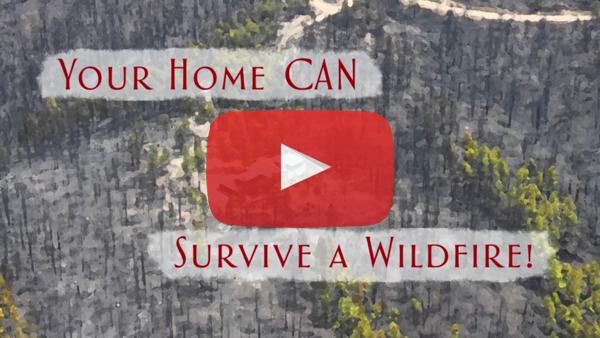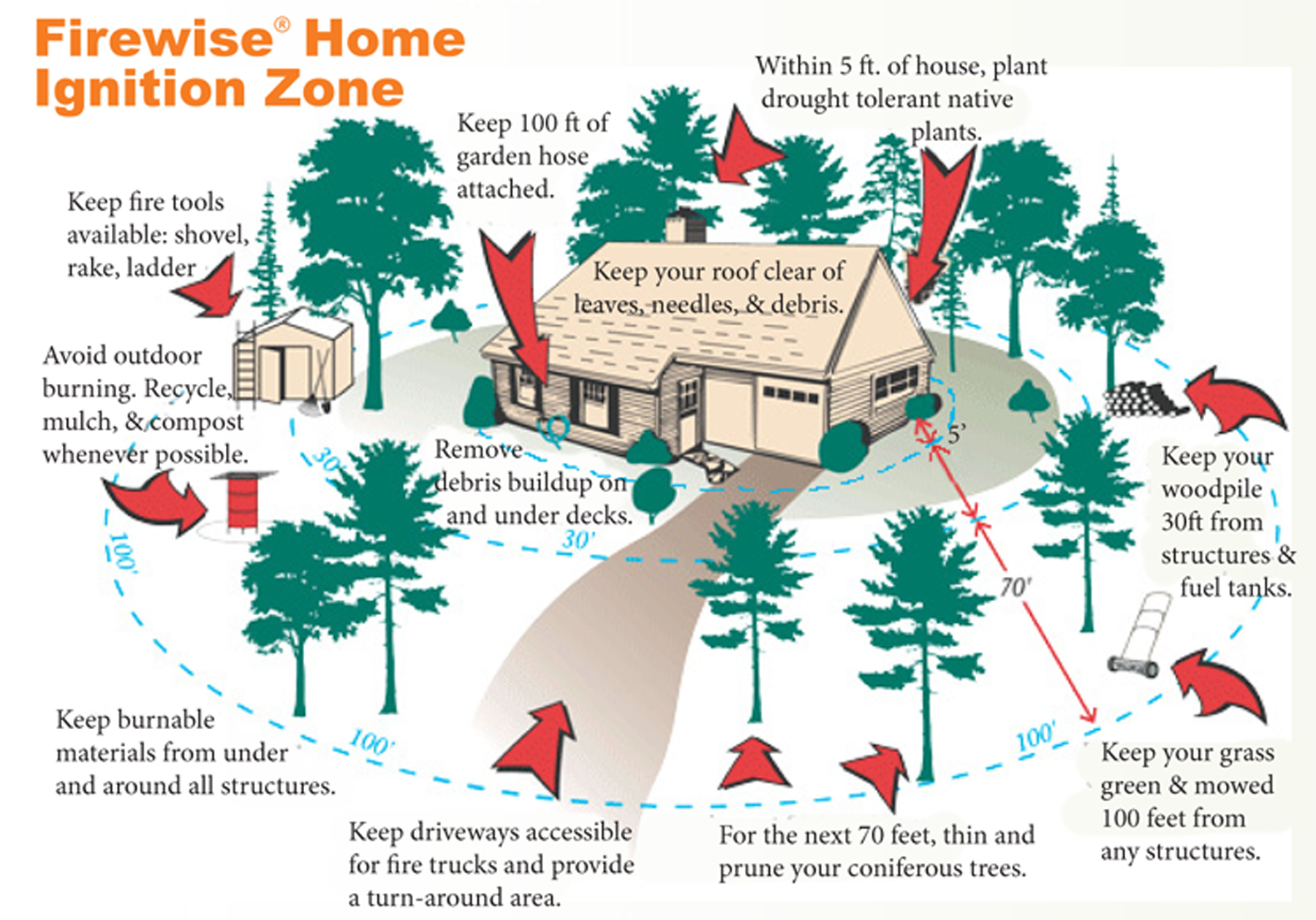Firewise Tips
Dr. Jack Cohen, Fire Science Researcher with the USDA Forest Service, explains current research about how homes ignite during wildfires, and the actions that homeowners can take to help their home survive the impacts of flames and embers.
NFPA’s Firewise program teaches how to adapt to living with a wildfire and promotes knowledge about wildfire safety. It is important that members of our community also know how to prepare and protect their families and their homes from wildfire concerns.
Keep Grass Cut Low
Rain keeps our fire danger low for a while, but it also helps the grasses grow tall. When tall grass dries out, it becomes light, flashy fuel where fires start easily and travel quickly. In the area within 50 to 100 feet of your structures, cut grass down to four to six inches in height. This will help protect your structures by reducing the size and intensity of fires. Also cut the grass under any trees or bushes with low-hanging branches, in an area extending three to five feet from the tree’s drip line. This will reduce the chance that tall grasses will become “ladder fuel” that carries a small ground fire into the crowns of the trees. By keeping grasses short, you’ll help wildfires stay small and on the ground, where firefighters have a better chance of managing them.
Stack Firewood Away From Your House
Firewood stacked close to your house, or under your deck, is like a time bomb. When wildfire embers settle into your wood pile, they will slowly build a fire that can destroy your home. Fortunately, you can reduce this risk by moving your wood pile at least 30 feet away from your house. Wood should be stacked level with the house or uphill, and at least 15 feet away from overhanging tree limbs. For convenience on cold nights, keep a small wood supply indoors, in a utility room, enclosed shed, or garage.
Remove "Dog-hair" Pines
We call these overcrowded, spindly saplings “dog-hair” because they’re thick as the hair on a dog’s back. But we should really call them just what they are: Dangerous fuel that makes wildfires more intense. Dog-hair acts as kindling that turns small ground fires into raging crown fires that are almost impossible to control. In a wild, uninhabited forest, nature removes these excess saplings with frequent, low-intensity fires. When we choose to live in the forest, we must clear out the dog-hair ourselves. Fortunately, you can remove this dangerous fuel with a simple bow saw or a pair of branch loppers.
Cut Low, "Ladder" Limbs
We call those low-hanging branches “ladder fuel” because they can easily carry a tame ground fire into the crowns of the pines. Once the fire is in the treetops, it becomes a huge fire that’s extremely hard to control. But you can help a fire stay on the ground by taking its ladder away: Simply cut off those low-hanging limbs. For tall, mature trees, remove all limbs at least ten feet off the ground. A bow saw on the end of a pole (shown here) is a good tool for that job, because it lets you work safely from the ground. When limbing smaller trees that you want to keep, trim the lower 1/3 of the tree’s height.
Keep Tools Clean and Sharp
As soon as spring arrives, we all reach for our saws to resume the work of caring for our piece of the forest. Keeping your forest management tools sharp and ready is a good project for a winter day:
- Chainsaws: Dig out the owner’s manual, and follow its recommendations for cleaning and routine maintenance. Sharpen the chain, or replace it. If you’re not confident doing these jobs, take your chainsaw to a saw shop. Winter is their slow time, too!
- Hand Saws: Replace damaged or dull blades, or have a saw shop sharpen them. Remove sticky sap by wiping the blade with a small amount of solvent (follow the safety instructions, and stay away from heat sources). Buff off rust with fine sandpaper or plain steel wool. Protect clean blades by wiping lightly with oil.
Make an Evacuation Plan
Winter is a great time to improve our preparedness for future wildfires or other emergencies. In one snowy afternoon, you can get started by making a simple evacuation plan. As you develop your plan, involve your children. They’ll feel more in control of their lives, and will do a better job of following the plan when it’s needed.
If you’ve already made an evacuation plan, good for you! But review that plan at least once per year to make sure that all information is current. Here’s what should be in your evacuation plan:
- Know two (or more) ways out of your neighborhood, so you can travel away from the emergency. If you only have one way out, you may need to decide to leave sooner than people who have more options.
- Choose a place where your family members will meet if you cannot communicate with each other.
- Choose one or two out-of-area relatives or friends to be your emergency contact point. When local phone circuits are tied up, you may be able to call long distance.
- Make a paper list of essential phone numbers. Don’t rely on the contacts stored in your mobile phone – you’ll lose that information as soon as the battery runs down. List all members of your family, your out-of-area contact, and any other numbers you’ll need in an emergency: schools, doctors, insurance agent, etc.
- List the essential items that you must take with you, and where those items are kept. In the stress of an evacuation, don’t assume you will remember your purse, prescription medications, glasses, or even your evacuation kit.
When you’ve written down your plan, give a copy to each family member and your out-of-area contact. Keep a copy in your home in a place that’s easy to find.
Review Your Insurance Needs for Your Home and Business
One of the most difficult lessons of our 2018 fire was that many families were under-insured. Some are rebuilding homes smaller than the ones they lost, while others are paying the cost difference to rebuild homes of the same size. The fire also destroyed the assets and records of many home-based businesses, and most of those businesses were completely uninsured.
This winter, start an annual routine of meeting with your insurance agent to review your insurance coverage. Make sure that your homeowner’s insurance will cover the complete cost of rebuilding your current home and replacing its contents. If you own a business, insure against the loss of its assets, as well as the cost of business interruption.
Update Your Home Inventory Photos
Soon after your family has unwrapped the Christmas gifts, photograph each new item to add to your household inventory. As you photograph each item, include images of its model number or other identifying information. These details will help you establish its value in the future, if necessary.
Make a Family Emergency Kit
Your family can cope with an emergency much easier if you’ve gathered some essential supplies in advance. Your emergency kit – or “go kit” – should provide your family’s basic needs for at least three days.
Making a “go kit” is a great project to keep kids busy while they’re home from school over the holidays. Start by giving them an example list (available from the American Red Cross or Ready.gov). Ask them to suggest what items your family needs, what isn’t necessary, and what your family should add (remember your pets). Include them in the decision about how many kits your family needs, and where they should be kept.
Once you agree on what your family’s kit should include, let the kids gather the items that you already own, and make a list of items you need (watch for items to go on sale). Finally, let them build the kits, and assign them the duty of updating them each year.


